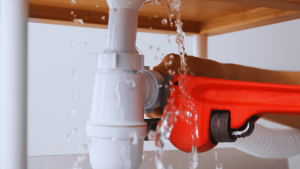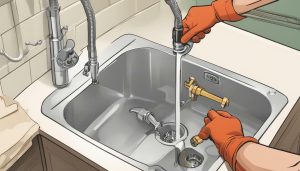Keeping your kitchen cabinets clean is essential for maintaining a hygienic and visually appealing kitchen. However, cleaning kitchen cabinets can be challenging, especially if you want to avoid damaging the finish. Using abrasive cleaners or rough materials can leave unsightly scratches and compromise the protective layer of your cabinets. In this article, we will explore safe cleaning methods for kitchen cabinets that will keep them looking beautiful for years to come.
Key Takeaways
- Properly cleaning kitchen cabinets without damaging the finish requires using gentle cleaning methods.
- Understanding the type of finish of your cabinets is crucial for determining the appropriate cleaning technique.
- Avoid using harsh chemicals and materials when cleaning kitchen cabinets to prevent scratches and damage to the protective layer of your cabinets.
Understanding Your Cabinet Finish
Preserving your cabinet finish during cleaning is essential to maintain the beauty and value of your kitchen cabinets for a long time. Different cabinet finishes have unique vulnerabilities that require specific cleaning techniques to preserve their quality. Here are some tips for identifying your cabinet finish and understanding its cleaning requirements:
- Start by identifying the type of cabinet finish you have. Common finishes include paint, stain, and laminate. Paint finishes are smooth and shiny, while stained finishes highlight the natural wood grain. Laminate finishes are made of synthetic materials that mimic the look of wood, and typically have a high-gloss finish.
- Once you have identified your cabinet finish, read the manufacturer’s instructions for cleaning and maintenance. These instructions provide specific cleaning tips suited to your cabinet finish and can help avoid damage during cleaning.
- Test any cleaning solution on a small, inconspicuous area of your cabinet before using it on a larger surface. This will help you avoid causing damage if the solution is not suitable for your cabinet finish.
- Use a soft, damp cloth to clean your cabinets, avoiding harsh materials or abrasive scrubbing techniques that can scratch or damage the finish. For tough stains, use a mild cleaning solution and gentle scrubbing method.
- Protect your cabinet finish from excessive moisture or sunlight. Excessive moisture can cause mold or mildew growth, while sunlight can fade the color or cause warping.
By understanding your cabinet finish and using non-damaging cleaning techniques, you can maintain a beautiful cabinet finish for years to come.
Gentle Cleaning Techniques
When it comes to cleaning your kitchen cabinets, gentle methods are always the best. Not only do they effectively remove dirt and grime, but they also preserve the finish of your cabinets. Follow these best practices for cleaning kitchen cabinets:
- Start with the right tools: Use a soft, microfiber cloth or sponge to wipe down the cabinets. Avoid using abrasive materials like steel wool or scrub brushes, as they can scratch the surface.
- Choose a mild cleaning solution: Mix a few drops of dish soap with warm water to create a gentle cleaning solution. You can also use a half-and-half mixture of white vinegar and water for tougher stains.
- Test a small area: Before you start cleaning the entire cabinet, test your cleaning solution on a small, inconspicuous area. This will help you ensure that the solution doesn’t cause any damage.
- Wipe in the direction of the grain: When wiping down your cabinets, make sure to follow the direction of the grain. This will prevent any damage to the finish.
- Dry thoroughly: After cleaning, make sure to dry your cabinets thoroughly with a clean, dry cloth. This will prevent any water damage or streaks.
By following these gentle cabinet cleaning methods, you can ensure that your kitchen cabinets stay clean and beautiful for years to come.
Removing Stubborn Stains
While gentle cleaning techniques work for most stains, there may be some stubborn stains that require a bit more effort to remove. However, it’s important to be cautious and avoid using harsh chemicals or abrasive materials that can damage the cabinet finish.
If you’re dealing with a tough stain, start by trying a gentle solution of warm water and mild dish soap. Apply the solution to a soft cloth and gently rub the affected area. Rinse the cloth with clean water and continue to wipe the area until all soap residues are gone. If the stain persists, try using a non-abrasive cleaner like baking soda or vinegar.
For particularly stubborn stains, avoid using harsh chemicals like bleach or ammonia, which can strip the cabinet finish. Instead, opt for a stain remover specifically designed for the type of cabinet finish you have. Be sure to test the solution on an inconspicuous area first to ensure that it doesn’t cause damage.
When scrubbing the stain, always use a soft cloth or sponge. Avoid using steel wool or abrasive scrub brushes, which can leave scratches on the surface of the cabinet. Remember to wipe the area with clean water and dry it thoroughly with a cloth to prevent water damage.
By following these tips, you can effectively remove stubborn stains without damaging your cabinet finish.
Avoiding Harmful Cleaning Agents
When it comes to cleaning your kitchen cabinets, using safe and non-damaging cleaning methods is essential to preserving the finish. Many cleaning agents contain harsh chemicals that can harm the surface of your cabinets over time. Here are a few tips for avoiding harmful cleaning agents:
- Avoid using bleach: Bleach can damage the finish of your cabinets and may even discolor them. Instead, opt for a mild cleaning solution like dish soap and warm water.
- Avoid abrasive cleaners: Abrasive cleaners like scouring pads can scratch and damage the surface of your cabinets. Use a soft cloth or sponge instead.
- Avoid acidic cleaners: Cleaners that are acidic, like vinegar or lemon juice, can etch the surface of your cabinets and cause damage. Stick to mild cleaners and avoid harsh acids.
By using safe and gentle cleaning methods, you can keep your kitchen cabinets looking beautiful for years to come.
Tips for Maintaining Cabinet Finish
Maintaining your kitchen cabinet finish is essential for preserving their beauty and ensuring their longevity. Here are some tips to keep your cabinets looking their best:
- Wipe cabinets regularly: Wipe down your cabinets regularly with a soft, damp cloth to remove any dust or dirt that may accumulate. This prevents buildup and makes more thorough cleaning easier.
- Avoid excessive moisture: Excessive moisture can damage your cabinets, so avoid placing hot or wet items directly on the surface. Be sure to wipe up any spills as soon as they happen.
- Protect from sunlight: Prolonged exposure to sunlight can cause discoloration, fading, and cracking of your cabinet finish. Consider covering windows or using curtains to limit direct sunlight.
- Use gentle cleaning methods: Using harsh chemicals or abrasive materials can damage your cabinet finish. Instead, use gentle cleaning solutions and soft cloths to clean your cabinets. See Section 3 for more information on gentle cleaning techniques.
- Polish and wax: Polishing and waxing your cabinets can help maintain their shine and protect against damage. Be sure to follow manufacturer recommendations and avoid buildup.
- Inspect your cabinets: Regularly inspect your cabinets for signs of wear, such as chips or scratches in the finish. Address any issues as soon as possible to prevent further damage.
By following these tips, you can maintain the beauty and integrity of your kitchen cabinets for years to come.
Dealing with Grease Buildup
One of the most common challenges when cleaning kitchen cabinets is dealing with the buildup of grease. This can be especially problematic for cabinets located above the stove or near the cooking area, where grease can accumulate quickly.
Fortunately, there are several best practices for cleaning kitchen cabinets that can help remove grease without damaging the cabinet finish:
- Start by wiping down the cabinets with a soft, damp cloth to remove any loose dirt or debris.
- Mix a solution of warm water and mild dish soap in a bowl or spray bottle.
- Apply the solution to a soft cloth and gently scrub the cabinets in a circular motion.
- For stubborn grease buildup, mix a paste of baking soda and water and apply it to the affected area. Let it sit for a few minutes before scrubbing with a soft cloth.
- Avoid using harsh cleaning agents or abrasive materials, such as steel wool or scrub brushes, as these can damage the cabinet finish.
By using these non-damaging cabinet cleaning techniques, you can effectively remove grease buildup from your kitchen cabinets while preserving their beautiful finish.
Special Considerations for Different Cabinet Materials
When it comes to cleaning kitchen cabinets, it’s important to consider the type of material your cabinets are made of. Different materials require specific cleaning techniques to preserve their finish and avoid damage. Here are some tips for cleaning cabinets made of different materials:
Wood Cabinets
Wood cabinets are classic and timeless, but they require special care to maintain their beauty. To clean wood cabinets, use a mild cleaner and a soft cloth. Avoid using abrasive sponges or harsh chemicals that can scratch or damage the wood. You may also want to apply a protective wax or polish to help prevent scratches and extend the life of the wood.
Laminate Cabinets
Laminate cabinets are affordable and durable, but they can be easily scratched. To clean laminate cabinets, use a mild cleaner and a soft cloth. Avoid using steel wool or abrasive sponges that can scratch the surface. Laminate cabinets can also be sensitive to excessive moisture, so avoid using a soaking wet cloth when cleaning them.
Metal Cabinets
Metal cabinets are sturdy and modern, but they can be susceptible to rust. To clean metal cabinets, use a mild cleaner and a soft cloth. Avoid using abrasive sponges or steel wool that can scratch the surface. After cleaning, dry the cabinets thoroughly to prevent water spots and rust.
By following these tips and using safe cleaning methods, you can keep your kitchen cabinets looking great for years to come.
Tips for Maintaining a Beautiful Cabinet Finish
Proper maintenance is the key to keeping your kitchen cabinets looking like new. Here are some additional tips to help you maintain a beautiful cabinet finish:
- Polishing: Regularly polishing your cabinets can help protect the finish and keep them looking shiny. Use a high-quality cabinet polish and a soft cloth to apply it. Avoid using too much polish, as this can cause buildup over time.
- Waxing: Applying a coat of wax to your cabinets can provide an extra layer of protection against scratches and wear. Use a soft cloth to apply a thin layer of wax, and then buff it off with a clean, dry cloth.
- Protecting from moisture: Too much moisture can cause damage to your cabinet finish over time. To prevent this, wipe up any spills or splatters immediately using a clean, damp cloth. Avoid using abrasive materials or harsh cleaners, as these can scratch the finish.
- Protecting from sunlight: Exposure to sunlight can cause fading and discoloration on your cabinets. To prevent this, avoid placing your cabinets in direct sunlight. If this is not possible, consider using window treatments to reduce exposure.
- Regular cleaning: Regularly cleaning your cabinets using gentle cleaning methods can help preserve the finish and keep them looking beautiful. Follow the tips outlined in the previous sections to ensure you are using safe and effective cleaning techniques.
By following these tips, you can ensure your kitchen cabinets maintain their beautiful finish for years to come.
Conclusion
Keeping your kitchen cabinets clean is important for maintaining their appearance and prolonging their lifespan. However, it is equally important to ensure that you do not damage the finish while cleaning. By understanding your cabinet finish and using safe, non-damaging cleaning techniques, you can keep your cabinets looking beautiful for years to come.
Remember to use gentle cleaning solutions and soft materials when cleaning your cabinets, and avoid harsh chemicals that can cause damage. Regular maintenance is also key to preserving your cabinet finish, so be sure to clean them regularly and protect them from excessive moisture and sunlight.
By following the tips outlined in this article, you can safely clean your kitchen cabinets without causing any damage. With a little care and attention, your cabinets can continue to look as good as new for many years to come.
FAQ
Q: How often should I clean my kitchen cabinets?
A: It is recommended to clean your kitchen cabinets at least once every few months to prevent a buildup of dirt and grime.
Q: What cleaning solution should I use for my cabinets?
A: For most cabinet finishes, a mild soap and water solution or a mixture of vinegar and water can be used. Avoid using harsh chemicals or abrasive cleaners.
Q: Should I use a sponge or a cloth to clean my cabinets?
A: It is best to use a soft microfiber cloth or a sponge with a non-abrasive side to prevent scratching the cabinet surface.
Q: How do I remove sticky residue from my cabinets?
A: You can remove sticky residue by using a mixture of warm water and dish soap. Gently scrub the affected area with a soft cloth or sponge.
Q: Can I use a furniture polish or wax on my cabinets?
A: It depends on the type of cabinet finish. Some finishes may benefit from polishing or waxing, while others may not require it. Refer to the manufacturer’s guidelines or consult a professional for specific recommendations.
Q: How can I protect my cabinets from moisture damage?
A: To protect your cabinets from moisture damage, avoid excessive exposure to water and wipe up spills immediately. Consider using cabinet liners or installing a dehumidifier in humid environments.
Q: Can I use a steam cleaner on my cabinets?
A: It is generally not recommended to use a steam cleaner on cabinets, as the high heat and moisture can damage the finish. Stick to gentle cleaning methods using mild solutions and soft materials.
Q: What should I do if I accidentally scratch the cabinet surface?
A: For minor scratches, you can try using a touch-up marker or a matching furniture polish to conceal the damage. For deeper scratches, it may be best to consult a professional for repair options.
Q: Are there any cleaning products I should avoid using on my cabinets?
A: Yes, avoid using bleach, ammonia, abrasive cleaners, and any products containing harsh chemicals. These can strip the finish or cause discoloration.
Q: Can I clean the inside of my cabinets with the same method?
A: Yes, you can use the same gentle cleaning methods on the inside of your cabinets. Make sure to remove the contents before cleaning and allow the cabinets to dry thoroughly before restocking.

It’s me, Amber Hayden, the heart and soul behind SagarmathaOnlineMedia.com. From a young age, I’ve been head over heels for everything home-related, from interior decor to gardening. I’m the type who can’t resist a well-crafted piece of furniture, and I firmly believe that a home isn’t complete without a pet or two. But it’s not just about creating pretty spaces for me. I’m all about making homes that tell a story reflecting the people living there. SagarmathaOnlineMedia.com is my way of sharing this passion with you. Whether you’re looking for tips to jazz up your living room, advice on pet care, or ideas to make your garden bloom, I’m here to help. So, let’s embark on this journey together and make your house a home!



